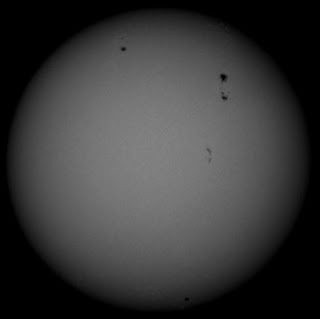December 29th 1115 GMT Sun
After what seemed like months but was actually only six days, I
saw some faint sunlight coming through a window. Further investigation showed
clouds moving across the solar disc. I checked the sun with my binoculars and
filters and saw two sunspots. The larger one was accompanied by a smaller one.
I produced a drawing of the sunspots.
December 23rd 0805 GMT Moon
It was clear as dawn was ending. The waning crescent Moon
was in the south west. I snapped it with my DSLR camera at 300mm focal length,
ISO 100 and 1/250 second exposure. However, the images were out of focus.
Unfortunately, it clouded over after sunrise, so I could not
take any photos of the Sun.
December 22nd 2310 GMT Binocular Session
The sky was clear but there was a strong, cold wind. I
hadn't seen many objects visually for a while. Where better to start than the
Pleiades, better known as the Seven Sisters. They looked superb, showing about
80 stars. The star cluster Melotte 20 was striking, too, although their height
above the horizon not doing my neck any favours. I also saw the star clusters
M34 in Perseus and M36. M37 and M38 in Auriga. I also saw the Perseus
Double Cluster and M35 in Gemini.
I saw two galaxies: the Andromeda Galaxy (M31) and the
Pinwheel (M33). These clearly showed their bright nuclei and fainter outer
arms.
I ended up estimating the brightness of Betelguese as
magnitude 0.5.
December 22nd 1655 GMT Venus and Jupiter
I set my DSLR camera to 300mm focal length, ISO 100 and
1/400 second exposure.
I snapped Venus then Jupiter. The Jupiter shots were underexposed but the Venus shots showed a phase. I stacked 5 images in Autostakkert and finished in GIMP.
December 22nd 1100 GMT Sun
I snapped the Sun with my DSLR and filter at 300mm
focal length, ISO 100 and 1/1000 second exposure. I caught some shading due to sunspots but the image was out of focus.
December 20th 2315 GMT Moon and Mars
I took some shots of the Moon and Mars with my phone camera.
December 20th 2215 GMT Mars with Jupiter and Orion
I had a quick session with my phone camera. The first set of
photos were aimed at Jupiter and Mars. For some unknown reason, the images were out of focus.
The second set of photos was of Orion. I also captured Sirius, a.k.a. the Dog Star.
December 19th 2245 GMT Moon and Mars
December 19th 1625 GMT Venus
December 19th 0915 GMT Moon and Sun
December 16th 2055 GMT Moon
I photographed the Moon with my Mak and DSLR at 1.54m focal length, ISO 100 and 1/500 second exposure.
December 16th 2025 GMT Moon with Jupiter and Mars
I used my phone camera to capture the Moon with Mars and Jupiter.
December 16th 0900 GMT Sun
After a few days of bad weather, I finally had some clear sky and took some full disc snaps of the Sun with my Mak and DSLR at 1.54m focal length, ISO 100 and 1/500 second exposure.
December 13th 1930 GMT Moon
I tried to capture the Moon with Jupiter. It didn't work.
December 6th 0955 GMT Sun
It was almost clear, so I photographed the Sun with my Mak
and DSLR at my usual settings of 1.54m focal length, ISO 100 and 1/500 second
exposure.
December 6th 0130 GMT Jupiter and Mars
As the images on 3rd did not stack. I took several photos
with my phone camera again. These almost stacked but not quite.
December 3rd 2315 GMT Phone Camera Shots
I stacked over 20 images of Orion and this worked well. I even managed to show the Orion Great Nebula (M42).
December 3rd 1110 GMT Sun
The Sun was behind some thin cloud. I snapped it with my Mak and DSLR at 1.54m focal length, ISO 100 and 1/320 second exposure. I used a slightly longer exposure than usual to counteract the conditions. There was just a hint of a sunspot,


















No comments:
Post a Comment